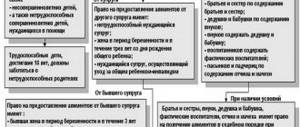What issues does the magistrate court deal with?
In accordance with the norms of the current civil legislation, magistrates deal with the following disputes:
- Divorce cases (if the spouses do not have a dispute about children);
- Cases on the division of property upon divorce (if the cost of the claim does not exceed 50 thousand rubles);
- Cases arising from family law relations (except for cases of paternity and parental rights);
- Cases on property disputes (if the value of the claim is less than 50 thousand rubles);
- Cases on determining the procedure for using property.
Note! If your claim does not fall under the category of cases within the jurisdiction of the magistrate's court, you need to apply to the district court at the place of residence or location of the defendant.
Sample design
There are cases when a claim is not accepted by the judge for consideration. For example, in the case of filing a claim on one’s own behalf, when the court decision in this case has already entered into legal force or it was drawn up with gross errors and requires corrections.
The court is obliged to consider the plaintiff’s petition, but it is extremely important to follow the procedure for pre-trial dispute resolution, so the application must be drawn up correctly and without errors.
Expert opinion
Kostenko Tamara Pavlovna
Lawyer with 10 years of experience. Author of numerous articles, teacher of Law
If the statement of claim is returned, the judge must indicate the reasons for the refusal and give recommendations on what can be corrected so that the next time the submitted document is not left without progress.
Only 5 days are allotted for consideration of the application , after which one or another appropriate decision will be made.
Features of the activities of a justice of the peace in 2019
The magistrate in the Russian Federation is a single-member judicial body. That is, this is an administrative person who has the right to consider cases that are not particularly complex in a simplified manner.
The main features of the activities of justices of the peace in 2021 include the following:
- Each justice of the peace is elected to a position by the legislative body of state power of the corresponding subject of the Russian Federation;
- The term of election to this position cannot exceed 5 years;
- The magistrate alone considers all cases within his competence;
- The requirements, orders and instructions of the magistrate are subject to strict execution throughout the entire territory of the Russian Federation.
Multiple respondents: design nuances
It often happens when several persons appear on the defendant’s side at once. In this case, you need to write as many applications as there are number of respondents. Moreover, it is necessary to reflect in order the data for each defendant: full name, residential address, contact numbers, so that the judge can call them to court at any time if necessary.
For each defendant separately, the application is drawn up in 3 copies: 1 remains with the plaintiff, 2 - in court, 3 is forwarded to the defendant. It is also advisable to make all copies in advance.
If a dispute with a counterparty cannot be resolved through negotiations and you are faced with the need to go to court, but for some reason cannot turn to the help of professional lawyers, we suggest using our step-by-step instructions, which contain step-by-step guidance on preparing and filing a claim .
Step 1. Identify the parties to the dispute - plaintiff, defendant(s), third parties.
A plaintiff is a person whose rights and interests have been violated and needs to be restored and protected by filing a claim. The defendant is the alleged violator of his rights, according to the plaintiff.
If the decision that ends the consideration of the dispute affects someone else’s rights and interests, such persons must be indicated in the claim as third parties (when establishing the circle of such persons, it is better to act on the principle of “the less the better”). You will need to indicate in the claim the addresses of the persons involved in the case.
Addresses can be obtained using information from the website https://egrul.nalog.ru/
Step 2. Formulate your demand against the defendant.
On the one hand, the demand must be based on the law, on the other hand, it reflects exactly what the plaintiff wants to receive as a result of the claim being satisfied by the court. For example, the buyer under a supply contract has the right to present to the supplier who delivered goods of inadequate quality one of several demands (to choose from): to proportionately reduce the purchase price, or to eliminate the defects free of charge within a reasonable time, or to reimburse its costs for their elimination.
There may be several claims in one claim if they are interrelated based on the basis for their occurrence and evidence.
Approach the wording of the claim(s) very carefully - adding a new claim (for example, to collect interest for the use of other people's funds in addition to the claim to collect debt under the supply agreement) will not work during the trial; you will have to file a separate claim, thereby You will lose time and incur additional financial expenses.
It is possible to change the demand later during the trial, but it is impossible to simultaneously change the basis (i.e., the circumstances on which the demand is based) and the subject of the claim (the demand itself against the defendant).
For example, for the above example, in the case of delivery of goods of inadequate quality, you can change the initially stated demand for the free elimination of defects in the goods with a demand for compensation for the costs of eliminating the defects of the delivered goods (the basis for both requirements is the delivery agreement). But it is impossible to change the requirement by referring to another agreement concluded between the parties.
We'll have to file another claim.
Sometimes the formulation of the claim and the identification of the defendant can be difficult. In this case, study judicial practice in cases with similar circumstances.
Look at what demands the plaintiffs made and how these demands were assessed by the court and how the case ended. The search for judicial practice can be carried out using legal systems, on the website ras.arbitr.ru/, on court websites, and on the Internet.
Give preference to the positions of higher courts, more recent judicial acts and judicial acts of the courts of your region, because Judicial practice is changeable.
Step 3. Determine the court that will hear the dispute.
As a general rule, a claim is filed in court at the location of the defendant. You should also study the provisions of the concluded agreement, if the claim is related to failure to fulfill contractual obligations - when concluding the agreement, the parties could agree on the court to which the dispute will be referred.
Expert opinion
Kostenko Tamara Pavlovna
Lawyer with 10 years of experience. Author of numerous articles, teacher of Law
For some categories of disputes, jurisdiction is established by law. Sometimes the law gives you the right to choose between several courts. Study the relevant articles of the procedural code.
If you make a mistake in the court's determination, this may delay the consideration of the case, because... the claim may not be accepted for proceedings, or during the proceedings will be transferred to another court.
If the limitation period for a dispute is about to expire, approach the court’s determination especially carefully - an error may result in the claim not being accepted for proceedings, which in turn may lead to the fact that re-filing the claim in another court will be outside the time limit, which the defendant may refer to. This will result in denial of your claims, even if they are justified.
Step 4: Gather evidence to support your claims.
The list of evidence is open - documents and other written evidence, physical evidence, expert opinions, witness statements, audio recordings, video recordings, specialist consultations, etc. Evidence may be in the possession of other persons.
In this case, you must take action to obtain such evidence yourself, or refer in your claim to the provisions of the law, by virtue of which your independent access to obtaining evidence is limited (for example, to the rules on bank secrecy, if the evidence is a bank account statement of another faces). If you were unable to obtain evidence on your own, you should attach documents to the claim confirming your attempts to obtain evidence, and include in the claim a petition to obtain evidence.
Written evidence shall be presented in originals or duly certified copies. The copy can be certified by a notary or an authorized representative of the plaintiff.
The law also established the possibility of presenting an extract from a document to the court. In some cases, it is required that the original evidence (for example, the original bill of exchange) be presented to the court, and the court may also require that the originals of any written evidence attached to the claim be presented in copies.
Electronic correspondence between the parties can also be presented as evidence. Ideally, the addresses from which correspondence is conducted should be specified as such in the contract, with a statement that messages sent to the parties' specified email addresses are equally recognized by the parties.
If this is not the case, the possibility of referring to the said correspondence and the assessment of its evidentiary value will be made by the court, taking into account the position taken by the defendant.
Screenshots (screenshots) from Internet pages can be used as evidence. Since information from the site can be deleted or changed, it would be more reliable to draw up a site inspection report from a notary.
If for some reason this is impossible or impractical, the screenshot should indicate the person who displayed the information on the screen, made the subsequent printout, and using what software.
Audio and video recordings are attached on tangible media with a transcript of the recordings on them, indicating the place and time of the recording and the persons involved.
Fig. 1 Site inspection protocol (excerpt)
Step 6: Calculate your debt
There is no form provided for calculating debt. It can be compiled in any form convenient for you, including in the form of a table.
The calculation must be arithmetically correct, justified, contain an indication of the amount of debt, the amount of interest rates applied, the number of days of the billing period, etc. The calculation must comply with the provisions of the law, agreement, clarifications of higher judicial authorities (see, for example, the Resolution of the Plenum of the Supreme Court of the Russian Federation dated 03.24.2016 N 7 “On the application by courts of certain provisions of the Civil Code of the Russian Federation on liability for violation of obligations”).
Rice. 2 Example of debt calculation:
Step 7. Pay the state fee
Expert opinion
Kostenko Tamara Pavlovna
Lawyer with 10 years of experience. Author of numerous articles, teacher of Law
Details for paying the state fee can be found on the website of the relevant court. The amount of the state duty is determined in accordance with the Tax Code of the Russian Federation, taking into account the cost of the claim and the category of the case.
The court website also has a calculator for calculating state fees. The state fee may be paid by the representative.
In this case, the payment document should indicate that the payer is acting on behalf of the represented person. The power of attorney must indicate the appropriate powers.
Step 8. Submit a claim
In cases established by agreement of the parties or by law, before filing a claim, it is mandatory to take measures to comply with the pre-trial procedure for resolving the dispute. Violation of this requirement will result in the return of the statement of claim or leaving the claim without consideration.
In your complaint, briefly and concisely describe the essence of the violation committed by the counterparty, with reference to the provisions of the law and/or contract, and indicate your requirement. Attach a copy of the claim with evidence of direction/service to the defendant to the claim.
Step 9. Write the text of the statement of claim
To do this, use the results of the work you carried out according to steps 1-8 of our guide.
Mandatory details of the claim:
Rice. 3 Example of the “header” of a claim
Step 10: Take steps to secure your claim
Think about what interim measure will be most effective for the requirement you have formulated (seizure of the defendant’s funds, prohibition to perform certain actions, transfer of disputed property for storage, suspension of execution of the disputed writ of execution, etc.). Draw up a petition for the application of interim measures, in which you justify the validity of their application.
Step 11. Send a copy of the claim and documents supporting the plaintiff’s claims to the parties involved in the case
Correspondence must be sent by registered mail with return receipt requested. We send only copies of documents that the defendant and other persons do not have.
Step 12. Create an application package
Step 13. File a lawsuit
To do this, take the claim to the court office, send it via Russian Post or courier service, or use the electronic document management system. It is advisable to send by a valuable letter with a description of the attachment.
Timely monitor the receipt of a claim in court and its acceptance for proceedings on the website https://kad.arbitr.ru/ If the court considers that your statement of claim and the documents attached to it do not fully comply with the requirements of the law, you will be asked eliminate the shortcomings of the claim within the time limits established by the court. If the court's requirements are not met, the statement of claim will be returned.
If they are completed in a timely manner, it will be considered filed on the day of initial receipt by the court.
If your legal dispute or other dispute, contractual work or any other form of activity concerns the issues discussed in this or other of our material, we recommend that you check and make sure that your legal position complies with the latest changes in practice and legislation.
We will be happy to provide you with legal assistance regarding minimizing legal risks and available opportunities. We will try to find a solution that suits you.
If you liked this material or any of our others, then recommend them to your colleagues, acquaintances, friends or business partners.
When it becomes necessary to defend your rights in court, you have to deal with many legal subtleties. When planning to file a claim, you need to not only draft it correctly, but also figure out how to submit a statement of claim to the court so that it is accepted.
How to file a statement of claim in the magistrate's court in 2019?
Like any other claim, the application to the magistrate must necessarily obey the rules established in Art. 131 Code of Civil Procedure of the Russian Federation. What rules are we talking about exactly?
Firstly, your application to the magistrates' court must be in writing (it does not matter too much whether you print the document on a printer or write it by hand - the main thing is that the text is legible and readable);
Secondly, the text of the application must contain the most complete information about the plaintiff and defendant, as well as the subject of the dispute (that is, you need not only to indicate your requirements to the magistrate’s court, but also to set out in detail all the information you have);
Thirdly, the statement of claim to the magistrate must be signed by the plaintiff (or his legal representative).
Evidence supporting the circumstances
As evidence confirming the above circumstances, a number of documents must be attached to the documentation, namely:
- Confirmation of unreliably provided information, provision of false information, for example, if the service provider does not have a license.
- Lack of necessary entries in the registry for this supplier.
- Inadequate fulfillment by the supplier of the terms of the contract.
- Lack of invoice to confirm actual deliveries.
- Presence of late payments.
- Threats, infringement of the rights and legitimate interests of the plaintiff.
All types of damage caused must be reflected in a separate column in the document, the amount of damage caused must be indicated, and copies of documents must be attached to confirm the given circumstances. If necessary, indicate the email address, place of work of the defendant, and other circumstances relevant to the case.
All data will be entered into the protocol, and the plaintiff will subsequently be issued a writ of execution.
Before submitting the application, you will need to pay a state fee of 200 rubles .
Where can I find a sample statement of claim to the magistrate's court in 2019?
On our website you can download a current sample statement of claim to the magistrate’s court and use it as the basis for your own claim:
Sample statement of claim to a magistrate (version current for 2021)
Note! If you doubt that you can prepare a claim on your own, you always have the opportunity to seek free help from our lawyers. The average waiting time for a response is 15 minutes .
Date of document creation
At the end of the application, in the right corner, you must put the date when submitting it to the court office. It is advisable to double-check the description of all the circumstances of the case, as well as the collected documents, so that there are no problems in the absence of any certificate, and the court representative does not reject the application.
If it is accepted for consideration, it will undergo registration and subsequent processing, i.e. redirection to legal proceedings. After which the court may set a date for a preliminary hearing in court.
How to find the address of the magistrate's court in 2019?
If you live in the capital, then you can easily find the address of the court you need on the Portal of the Unified Information Space of Justices of the Peace in Moscow.
Find the address of the magistrate court in Moscow>>>
Note! As a general rule, a claim is filed in the magistrate's court at the place of residence or location of the defendant.
List of attached documents
According to Article 152 of the Civil Code of the Russian Federation, a number of documents must be proposed, namely:
- Copies of the application according to the number of defendants.
- Passport.
- A document certifying the authority of the representative, certified by a notary when representing interests in court by proxy.
- Receipt of payment of state duty in the amount established by law.
- The right confirming the exemption from payment of duty, if any.
- Documents confirming the moral and material damage caused.
- Regulatory acts with the text of the challenge.
The document is submitted only in writing with a request to further regulate the process and in several copies: how many defendants and third parties.
How to properly submit an application to the Magistrates' Court? Procedure for 2021
In 2021, a claim may be submitted to the magistrate's court:
- In person - through the court office;
- By mail - by registered mail with acknowledgment of delivery.
Once your claim has been accepted and properly registered, the magistrate must consider accepting your claim for trial. He must do this within 5 working days - this is the period indicated in the text of Art. 133 Code of Civil Procedure of the Russian Federation.
Circumstances on the basis of which the claims were brought
The circumstances must be specified as a separate paragraph in the application when the plaintiff presents claims. All information in the document is genuine and the requirements must be qualified correctly.
The plaintiff bears full responsibility for the improper fulfillment of his obligations and the provision of false information. The circumstances will be considered the legal basis for the presentation of the requirements specified in the application.
It is important to reflect them in the motivation part of the document. The plaintiff will have to prove the indicated circumstances in court, which means that the relevant additional documents must be attached for confirmation.











